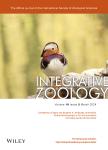Major ascaroside pheromone component asc-C5 influences reproductive plasticity among isolates of the invasive species pinewood nematode
作者机构:State Key Laboratory of Integrated Management of Pest Insects and RodentsInstitute of ZoologyChinese Academy of SciencesBeijingChina CAS Center for Excellence in Biotic InteractionsUniversity of Chinese Academy of SciencesBeijingChina
出 版 物:《Integrative Zoology》 (整合动物学(英文版))
年 卷 期:2021年第16卷第6期
页 面:893-907页
核心收录:
学科分类:0710[理学-生物学] 071001[理学-植物学] 07[理学] 0905[农学-畜牧学] 0906[农学-兽医学]
基 金:This work was funded by the National key R&D Program of China(2018YFC1200400) the Natural Science Foundation of China(31630013,31572272) the Frontier Science Key Project of the Chinese Academy of Sciences(QYZDJ-SSW-SMC024)
主 题:Bursaphelenchus xylophilus fecundity invasion phenotypic plasticity pheromone
摘 要:Pheromones are communication chemicals and regulatory signals used by animals and represent unique tools for organisms to mediate behaviors and make“decisionsto maximize their *** plasticity refers to the innate capacity of a species to tolerate a greater breadth of environmental conditions across which it adapts to improve its survival,reproduction,and *** pinewood nematode,Bursaphelenchus xylophilus,an invasive nematode species,was accidentally introduced from North America into Japan,China,and Europe;however,few studies have investigated its pheromones and phenotypic plasticity as a natural ***,we demonstrated a novel phenomenon,in which nematodes under the condition of pheromone presence triggered increased reproduction in invasive strains(JP1,JP2,CN1,CN2,EU1,and EU2),while it simultaneously decreased reproduction in native strains(US1 and US2).The bidirectional effect on fecundity,mediated by presence/absence of pheromones,is henceforth termed pheromone-regulative reproductive plasticity(PRRP).We further found that synthetic ascaroside asc-C5(ascr#9),the major pheromone component,plays a leading role in PRRP and identified 2 candidate receptor genes,Bxydaf-38 and Bxysrd-10,involved in perceiving *** results suggest that plasticity of reproductive responses to pheromones in pinewood nematode may increase its fitness in novel environments following *** opens up a new perspective for invasion biology and presents a novel strategy of invasion,suggesting that pheromones,in addition to their traditional roles in chemical signaling,can influence the reproductive phenotype among native and invasive *** addition,this novel mechanism could broadly explain,through comparative studies of native and invasive populations of animals,a potential underlying factor behind of the success of other biological invasions.



